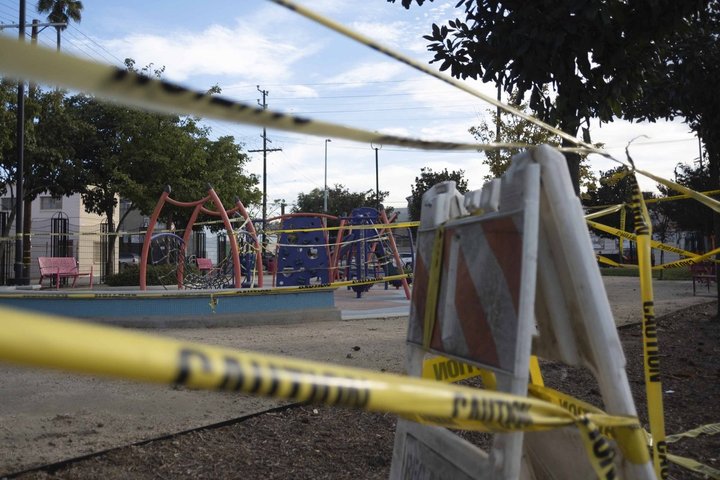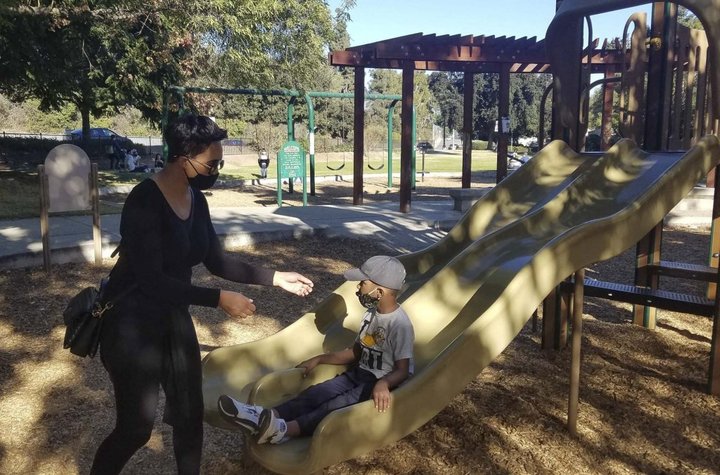
A cordoned off playground in South Central LA, on Dec. 8., 2020. Photo by Tash Kimmell for CalMatters.
###
California has backpedaled on closing playgrounds as part of its stay-at-home order after parents and legislators argued that children need outdoor play for their health.
The updated state guidance, posted yesterday, states that “playgrounds may remain open to facilitate physically distanced personal health and wellness through outdoor exercise.” The California Department of Public Health had been defending last week’s order closing outdoor playgrounds in hard-hit coronavirus regions, saying it was intended to keep families from mixing with those outside their households.
Some parents were ecstatic about the reversal and said they hoped their counties would also open play areas, as many have stricter rules and already had closed playgrounds.
“It is such a relief,” said Carmen Adler, who lives with her husband and two young sons in a Los Angeles apartment without a yard. “It will make winter break survivable.”
She took her children, 4 and 20 months, to the playground after work yesterday, calling the reversal “justice” for families.
Legislators who had pushed back also were pleased.
“Every parent knows how important playgrounds are for our youngest Californians,” said San Diego Democratic Assemblymember Lorena Gonzalez, who led the legislative effort on reopening playgrounds. She thanked Gov. Gavin Newsom “for hearing our collective concern and rethinking how we can open play structures for our kids.”
“Play is crucial for childhood development. But low-income communities of color living in dense housing often do not have access to a yard.”
— Hilda Solis, Los Angeles County Supervisor
After last week’s announcement, many parents were frustrated that playground closures were part of the new stay-at-home order, especially when certain retailers, indoor malls and outdoor tennis courts remained open, albeit with restrictions. They argued that children need to have access to playgrounds for their mental health and development, especially with schools closed.
They were not alone. A group of legislators, led by Gonzalez, sent a letter to Newsom on Friday, asking him to reconsider.
“Public playgrounds provide a shared outdoor resource for families without having to travel far, pay entrance fees, or need additional outdoor gear,” the letter stated.
It remains unclear if counties with closed playgrounds will follow the state’s new course. For instance, Los Angeles County issued its own stay-at-home order a week before the state’s — and its order included playground closures. Yesterday, county officials reversed its position and aligned with the state guidelines.
“Play is crucial for childhood development. But low-income communities of color living in dense housing often do not have access to a yard,” tweeted Los Angeles County Supervisor Hilda Solis. “With distance learning, having access to public playgrounds is more important now than ever.”
Regional stay-at-home orders went into effect across California this week, triggered by diminishing capacity in intensive care units. So far, most of California is under the order, including the Southern California and the San Joaquin Valley regions. Other areas, like San Francisco and surrounding counties, have elected to put the order in place ahead of the state requiring it.

Ericka Dean of Los Angeles greets her son Miles, 4, at the slide at Pasadena Park last weekend, just before the state’s stay-at-home order was to go into effect and close playgrounds. The state reversed the order yesterday and will allow playgrounds to stay open. Photo by Elizabeth Aguilera for CalMatters
On Saturday, the day before the Southern California regional stay-at-home order was to go into effect, several families visited a small Pasadena park for last-minute playground adventures. Pasadena kept its parks open longer than other cities in the area because the city had opted not to follow the county closures. The city has its own public health department.
On a swing, 2-year-old Brady Lutzeier swung his feet in the air as his dad pushed, while also keeping an eye on his three older children on a nearby teeter-totter.
David Lutzeier, who lost his job managing a fitness center at the beginning of the pandemic and is now a stay-at-home dad, said the park is his children’s only outlet. He said he has been getting anonymous letters from neighbors complaining his kids were too loud while playing in their own driveway.
“We stay at home as much as possible, but for the mental health of the kids, we come here,” he said. “At the park they are free to be children and run and play and be loud.”
Ericka Dean, who lives in a Los Angeles apartment with her husband and 4-year-old son, drove 25 minutes over the weekend to Pasadena because her neighborhood parks shut down a week earlier under county regulations.
The family does not have a yard and Dean called parks their safe haven. Dean’s husband is high risk, so they have been careful to find parks with few children.
“I get it’s an economic crisis but it’s also a familial crisis too,” she said. Children “rely on park playgrounds to retain a sense of normalcy through this pandemic.”
Not all parents questioned the closure of playgrounds.
Public health nurse Leah Elias-Nelson, who has a 3-year-old son, said she has had to ask parents at her neighborhood playground to wear masks – and to mask up their kids since playgrounds reopened. Many of these parents “seem to struggle with the idea of keeping distance.”
Elias-Nelson, a school nurse for the Los Angeles Unified School District, suffered from COVID-19 in the spring. She wasn’t surprised when playgrounds were cordoned off again by the state this week but, even with the latest reversal, she doesn’t plan to return to play structures any time soon. That doesn’t mean they won’t go to the park, she said, but they plan to stay in open grassy areas.
“I still feel as though we all must act as custodians of public health and do our part to slow the spread,” she said. “We need to be home and away from others, not congregating at playgrounds.”
“I get it’s an economic crisis but it’s also a familial crisis too.”
— Ericka Dean, Los Angeles parent
Public health decisions are often at odds with individual and community decisions, said Rebecca Fielding-Miller, assistant professor of public health at University of California, San Diego.
But this time, Fielding-Miller said, the state got it wrong. The reversal is a win for families and for evidence-based policy, she said.
“There is little to no evidence that playgrounds are a major driver of risk, and rather a lot of evidence that playing outside in the fresh air is good for children,” she said. “This was going to disproportionately hurt low-income and racialized minority children, who have already borne the educational, economic, and health brunt of the pandemic.”
She said she believes the decision to close playgrounds was more detrimental than the slight risk of being infected while running across a foot bridge, captaining a ship’s wheel or sliding down a twister slide.
California’s first order in March to close playgrounds made sense, she said, because health officials thought COVID-19 could be spread by touching surfaces. Later, it was determined that transmission is mainly airborne. Playgrounds were reopened in October.
“Now we know the safest place to be is to be outside if you are going to be with other people,” Fielding-Miller said. “Parks and playgrounds are not what is overwhelming the ICU, people gathering with their family at the holiday or working out in a gym is the driver.”
As long as families follow the guidelines, playgrounds pose a minimal risk, said Fielding-Miller, who has her own 3-year-old playground aficionado.
###
CalMatters coverage of early childhood issues is supported by grants from First 5 Los Angeles and The Ralph M. Parsons Foundation. CALmatters.org is a nonprofit, nonpartisan media venture explaining California policies and politics.
CLICK TO MANAGE